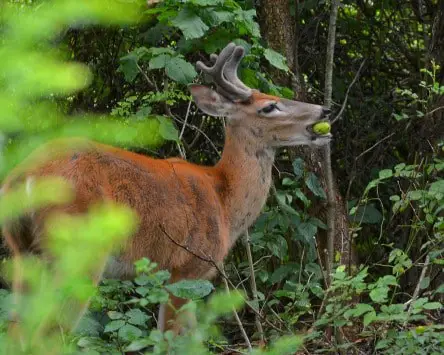Do Deer Eat Apples?
My brother, George, complained that when he put out the rotten apples, the deer won’t feed on them. I had the opposite experience. I had a few apple trees on my garden, and when they would ripen and fall, I’d only find a few. The deer ate the rest.
The conversation with my brother got me curious that I had to research how deer interact with apples. I found that apples and deer are like ham and eggs—they go together.
So to answer your question, do deer eat apples? yes they do. We can say that once the deer get used to them, they are like crack to them. Deer will eat any apple variety, including crab apples.
How do deer eat apples?
Think about it. How can you eat an apple if you don’t have front teeth on the upper jaw or you can’t take a bite? You might think it’s impossible, right? Well, the deer have a solution.
After picking the apple with their mouth, they move it to the back and crunch it up with their molars. Although awkward and often hilarious, it works!
How to deer-proof your apple tree
If you don’t want your precious apples eaten by the deer, there are several things you can do to keep them off. Some of these things include:
Put up a fence around the apple tree

A high-tensile or woven mesh wire fence will keep off the deer. When putting up the fence, anchor the wire firmly to the ground and fill any dips or holes with rocks or any other material that won’t easily blow away.
If you have the budget, go for a new Zealand-style electric fence.
Deer tend to jump high so ensure your fence is tall enough. According to the University of California, the minimum fence height should be 8-feet.
Place a metal or plastic mesh trunk guard
If you don’t have the money to construct a fence, consider placing a trunk guard around the bottom of the apple tree. This will prevent the male deer from scratching the velvet from their antlers.
Wrap the metal mesh around the tree taking care you don’t damage the bark. You should then secure the guard with the metal wire then press it into the ground.
Use scented soap

Deer are highly sensitive to strong smells so you can use this to your advantage. Tie strings around bars of scented soaps and hand them on the individual apple trees. The strong scent of the soaps will repel the deer.
Remember to closely monitor the soaps so that you can replace them as soon as they disintegrate.
If you have access to Milorganite, spread it around the base of the tree and the smell will put the deer off.
Use deer resistant plants
According to the California Department of Fish and Game, placing deer-resistant plants around the apple tree will deter the animals hence keep your apples safe.
Some of the varieties you can go with include: yarrow, aloe, rosemary, and monkshood. If you can’t find any variety in your area, check with your local nursery about the available species in your area.
When choosing the plants, you should note that some shrubs, deer-resistant plants, grasses, or trees are invasive or noxious. Others such as bamboo can quickly grow out of control, so be cautious about the plants you go for before planting.
Using apples as deer bait

If you are into hunting, you might be wondering if deer eat apples so you can use them as bait. As mentioned above, they do feed on them, and you can go ahead and use them as bait.
Before you put them out, ensure it’s legal in your state.
If your state allows it, plant a few apple trees in your backyard or buy them from your local farmers market.
If there are no other food varieties such as acorns in the area, deer will delightedly feed on the apples, but if there are other options, they might not even touch them especially if they aren’t used to them.
To attract the animals to the apples, consider crushing a few of them. The smell will call them.